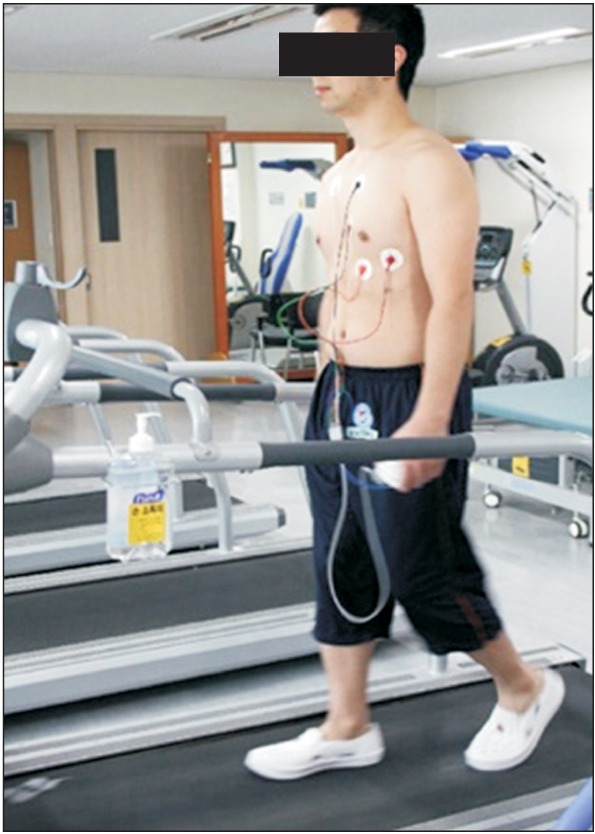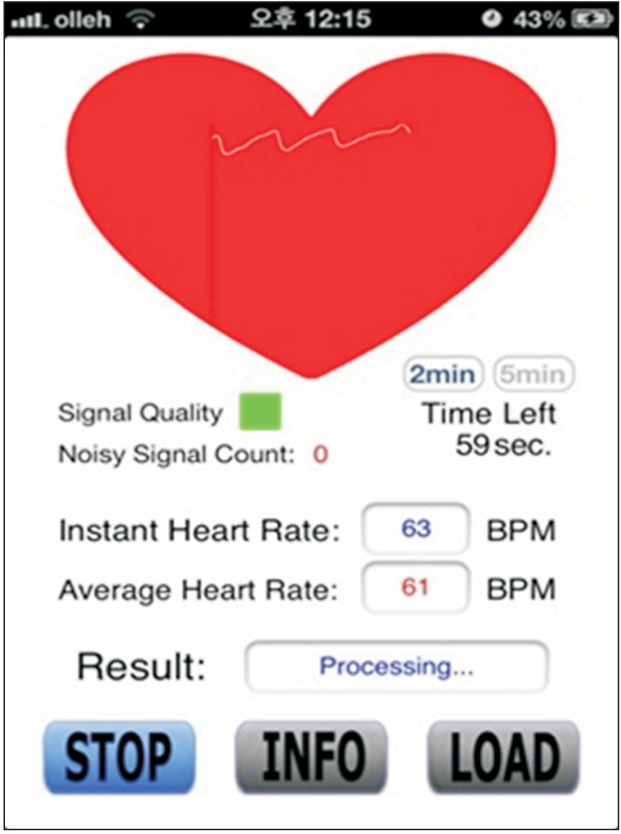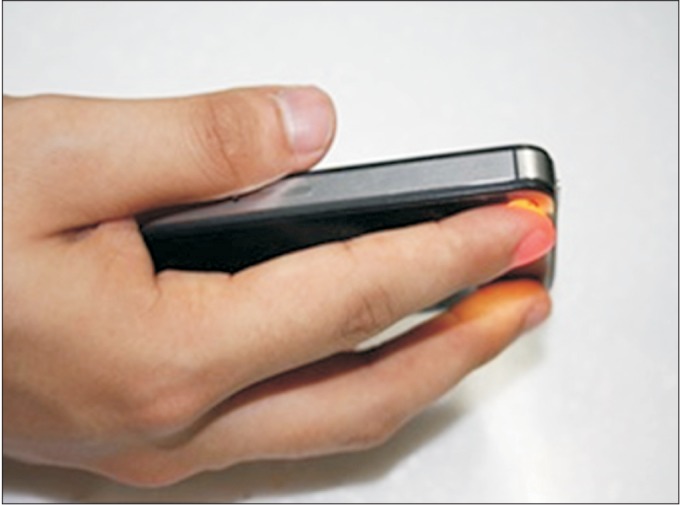Ann Rehabil Med.
2017 Feb;41(1):129-137. 10.5535/arm.2017.41.1.129.
Accuracy of Heart Rate Measurement Using Smartphones During Treadmill Exercise in Male Patients With Ischemic Heart Disease
- Affiliations
-
- 1Department of Rehabilitation Medicine and Institute of Wonkwang Medical Science, Wonkwang University School of Medicine, Iksan, Korea. wonrehab@wonkwang.ac.kr
- 2Department of Biomedical Engineering, Wonkwang University School of Medicine, Iksan, Korea.
- KMID: 2383687
- DOI: http://doi.org/10.5535/arm.2017.41.1.129
Abstract
OBJECTIVE
To evaluate the accuracy of a smartphone application measuring heart rates (HRs), during an exercise and discussed clinical potential of the smartphone application for cardiac rehabilitation exercise programs.
METHODS
Patients with heart disease (14 with myocardial infarction, 2 with angina pectoris) were recruited. Exercise protocol was comprised of a resting stage, Bruce stage II, Bruce stage III, and a recovery stage. To measure HR, subjects held smartphone in their hands and put the tip of their index finger on the built-in camera for 1 minute at each exercise stage such as resting stage, Bruce stage II, Bruce stage III, and recovery stage. The smartphones recorded photoplethysmography signal and HR was calculated every heart beat. HR data obtained from the smartphone during the exercise protocol was compared with the HR data obtained from a Holter electrocardiography monitor (control).
RESULTS
In each exercise protocol stage (resting stage, Bruce stage II, Bruce stage III, and the recovery stage), the HR averages obtained from a Holter monitor were 76.40±12.73, 113.09±14.52, 115.64±15.15, and 81.53±13.08 bpm, respectively. The simultaneously measured HR averages obtained from a smartphone were 76.41±12.82, 112.38±15.06, 115.83±15.36, and 81.53±13 bpm, respectively. The intraclass correlation coefficient (95% confidence interval) was 1.00 (1.00-1.00), 0.99 (0.98-0.99), 0.94 (0.83-0.98), and 1.00 (0.99-1.00) in resting stage, Bruce stage II, Bruce stage III, and recovery stage, respectively. There was no statistically significant difference between the HRs measured by either device at each stage (p>0.05).
CONCLUSION
The accuracy of measured HR from a smartphone was almost overlapped with the measurement from the Holter monitor in resting stage and recovery stage. However, we observed that the measurement error increased as the exercise intensity increased.
Keyword
MeSH Terms
Figure
Reference
-
1. World Health Organization. Prevention of cardiovascular disease: guidelines for assessment and management of cardiovascular risk. Geneva: World Health Organization;2007.2. Statistics Korea. Annual report on the cause of death statistics in 2014 [Internet]. Daejeon: Statistics Korea;2015. cited 2017 Jan 7. Available from: http://www.index.go.kr/potal/main/EachDtlPageDetail.do?idx_cd=1012.3. Smith SC Jr, Benjamin EJ, Bonow RO, Braun LT, Creager MA, Franklin BA, et al. AHA/ACCF secondary prevention and risk reduction therapy for patients with coronary and other atherosclerotic vascular disease: 2011 update: a guideline from the American Heart Association and American College of Cardiology Foundation. Circulation. 2011; 124:2458–2473. PMID: 22052934.4. Witt BJ, Jacobsen SJ, Weston SA, Killian JM, Meverden RA, Allison TG, et al. Cardiac rehabilitation after myocardial infarction in the community. J Am Coll Cardiol. 2004; 44:988–996. PMID: 15337208.
Article5. Suaya JA, Shepard DS, Normand SL, Ades PA, Prottas J, Stason WB. Use of cardiac rehabilitation by Medicare beneficiaries after myocardial infarction or coronary bypass surgery. Circulation. 2007; 116:1653–1662. PMID: 17893274.
Article6. Pfaeffli Dale L, Whittaker R, Dixon R, Stewart R, Jiang Y, Carter K, et al. Acceptability of a mobile health exercise-based cardiac rehabilitation intervention: a randomized trial. J Cardiopulm Rehabil Prev. 2015; 35:312–319. PMID: 26181037.7. Leijdekkers P, Gay V. Personal heart monitoring and rehabilitation system using smart phones. In : Proceedings of 2006 International Conference on Mobile Business; 2006 Jun 26-27; Copenhagen, Denmark. p. 29.8. Worringham C, Rojek A, Stewart I. Development and feasibility of a smartphone, ECG and GPS based system for remotely monitoring exercise in cardiac rehabilitation. PLoS One. 2011; 6:e14669. PMID: 21347403.
Article9. Strisland F, Svagard I, Seeberg TM, Mathisen BM, Vedum J, Austad HO, et al. ESUMS: a mobile system for continuous home monitoring of rehabilitation patients. Conf Proc IEEE Eng Med Biol Soc. 2013; 2013:4670–4673. PMID: 24110776.
Article10. Lee YH, Hur SH, Sohn J, Lee HM, Park NH, Cho YK, et al. Impact of home-based exercise training with wireless monitoring on patients with acute coronary syndrome undergoing percutaneous coronary intervention. J Korean Med Sci. 2013; 28:564–568. PMID: 23580444.
Article11. American College of Sports Medicine. ACSM's guidelines for exercise testing and prescription. 9th ed. Philadelphia: Lippincott Williams & Wilkins;2013.12. Scully CG, Lee J, Meyer J, Gorbach AM, Granquist-Fraser D, Mendelson Y, et al. Physiological parameter monitoring from optical recordings with a mobile phone. IEEE Trans Biomed Eng. 2012; 59:303–306. PMID: 21803676.
Article13. Lee J, Reyes BA, McManus DD, Maitas O, Chon KH. Atrial fibrillation detection using an iPhone 4S. IEEE Trans Biomed Eng. 2013; 60:203–206. PMID: 22868524.
Article14. Lee J, Chon KH. Time-varying autoregressive model-based multiple modes particle filtering algorithm for respiratory rate extraction from pulse oximeter. IEEE Trans Biomed Eng. 2011; 58:790–794. PMID: 20937577.15. Lee J, Chon KH. An autoregressive model-based particle filtering algorithms for extraction of respiratory rates as high as 90 breaths per minute from pulse oximeter. IEEE Trans Biomed Eng. 2010; 57:2158–2167. PMID: 20542761.16. Wallen MP, Gomersall SR, Keating SE, Wisløff U, Coombes JS. Accuracy of Heart Rate Watches: Implications for Weight Management. PLoS One. 2016; 11:e0154420. PMID: 27232714.
Article17. Crouter SE, Albright C, Bassett DR Jr. Accuracy of polar S410 heart rate monitor to estimate energy cost of exercise. Med Sci Sports Exerc. 2004; 36:1433–1439. PMID: 15292754.
Article18. Kwan G, Balady GJ. Cardiac rehabilitation 2012: advancing the field through emerging science. Circulation. 2012; 125:e369–e373. PMID: 22354982.19. Dunlay SM, Witt BJ, Allison TG, Hayes SN, Weston SA, Koepsell E, et al. Barriers to participation in cardiac rehabilitation. Am Heart J. 2009; 158:852–859. PMID: 19853708.
Article20. Jolly K, Taylor R, Lip GY, Greenfield S, Raftery J, Mant J, et al. Home-based compared with hospital-based cardiac rehabilitation in a multi-ethnic population: cost-effectiveness and patient adherence. The Birmingham Rehabilitation Uptake Maximisation Study (BRUM). Health Technol Assess. 2007; 11:1–118.
Article21. Terbizan DJ, Dolezal BA, Albano C. Validity of seven commercially available heart rate monitors. Meas Phys Educ Exerc Sci. 2002; 6:243–247.
Article
- Full Text Links
- Actions
-
Cited
- CITED
-
- Close
- Share
- Similar articles
-
- Comparison of Myocardial Oxygen Demand and Rate of Perceived Exertion According to the Modes of Exercise in Ischemic Heart Disease
- Relation between Ischemia on Exercise Testing and on Holter Monitoring
- The difference of heart rate recovery in ischemic heart disease comparing to normal
- Heart Rate Recovery in Coronary Artery Disease and the Changes of Exercise Parameters after Coronary Stenting
- Comparison of Heart Rate and Oxygen Consumption between Walking and Running at the Same Condition of Treadmill




